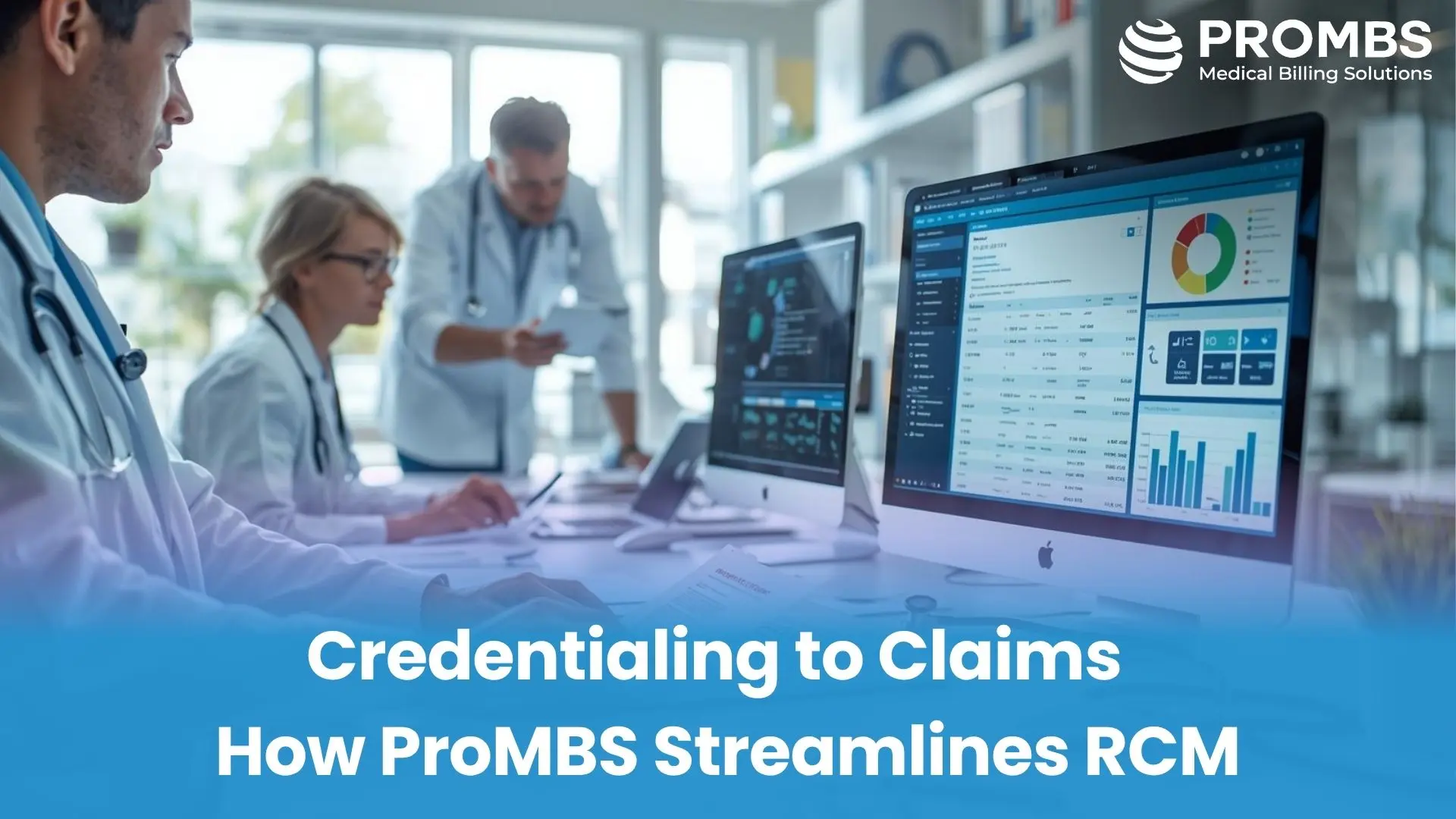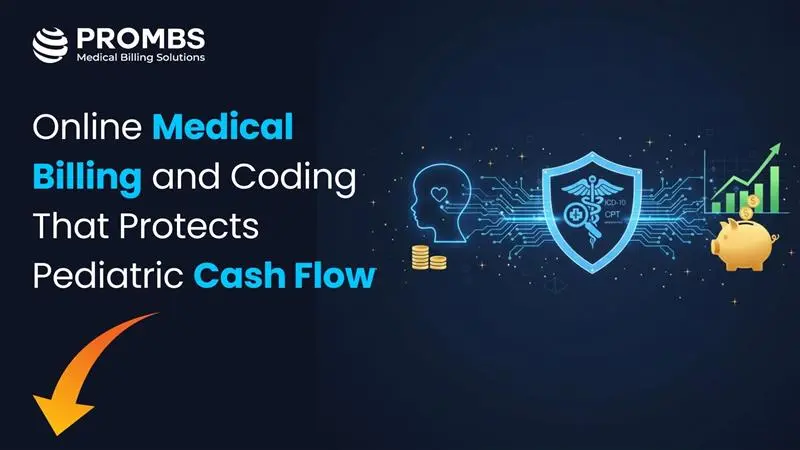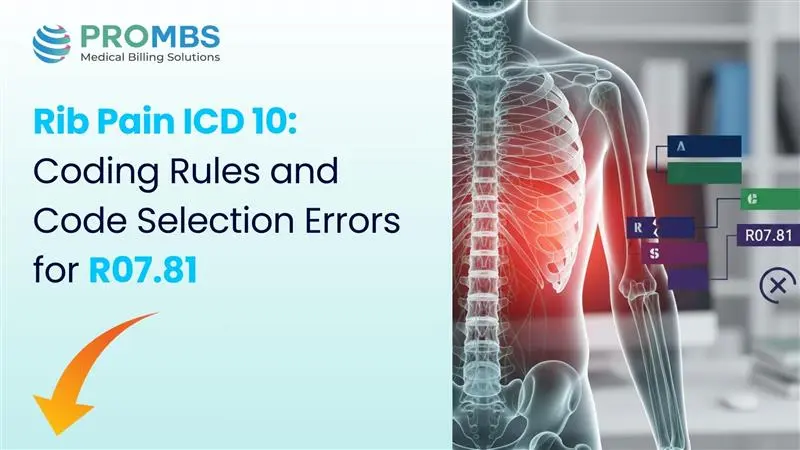In healthcare revenue cycle management (RCM), the journey from provider credentialing to claim submission and payment determines whether organizations are reimbursed efficiently or left battling denials and underpayments. According to the American Hospital Association (AHA), delays and errors in credentialing and claims submission contribute to billions in lost revenue each year.
PROMBS has built a credentialing to claims workflow that unifies every stage, from onboarding providers and enrolling them with payers to capturing charges, scrubbing claims, and following up on AR. Our process-driven approach delivers trust, compliance, and efficiency, ensuring that clients not only secure reimbursement but also build sustainable revenue integrity.
Provider Onboarding
The starting point of the credentialing to claims workflow is provider onboarding, where accuracy and compliance set the tone for the entire revenue cycle. If errors occur during onboarding, such as incomplete demographic records or outdated CAQH profiles, they ripple downstream, delaying payer enrollment, blocking claim approvals, and creating denials that could have been avoided. According to the American Medical Association (AMA), onboarding is not simply paperwork; it is the compliance backbone that ensures providers can bill and get reimbursed correctly from day one.
| Onboarding Element | Industry Standard | PROMBS Approach |
|---|---|---|
| Demographic Intake | Must include NPI, DEA, licensure, and taxonomy, validated against CMS enrollment standards. | PROMBS standardizes intake workflows across EHRs and payer databases to prevent data mismatches. |
| CAQH Profile Setup | Payers require updated CAQH ProView profiles before credentialing acceptance. | PROMBS ensures real-time CAQH updates with complete and accurate provider information. |
| License & Certification Verification | State and national licensure validated against AMA and respective state boards. | PROMBS integrates automated checks into onboarding to prevent lapsed or expired credentials. |
| Exclusion Screening | Providers must be screened against the OIG LEIE and SAM.gov to avoid fraud risk. | PROMBS embeds exclusion monitoring directly into the onboarding step. |
| Practice Location Setup | Provider practice sites must align with payer rosters and Medicare PECOS records. | PROMBS validates practice addresses and affiliations to avoid roster denials. |
Why Onboarding Accuracy Matters
Provider onboarding is often underestimated, but its impact on revenue is significant. If a provider is incorrectly set up in the system, claims tied to that provider can be denied as “not enrolled” or “invalid provider ID.” PROMBS prevents this by making onboarding data-driven, standardized, and audit-ready, so errors are resolved before they ever reach payers. Strong onboarding reduces delays in payer enrollment, accelerates the first claim submission, and ensures every downstream process, from charge capture to AR follow-up, rests on a solid compliance foundation.
Did You Know? The Medical Group Management Association (MGMA) found that 85% of credentialing-related claim denials trace back to onboarding errors, such as missing demographic data or outdated licensure records. PROMBS’ structured onboarding eliminates these preventable risks.
Charging Capture
After onboarding, the next critical step in the credentialing to claims workflow is payer enrollment. Even if a provider is fully licensed and credentialed, claims will be denied unless they are actively enrolled and linked to payer networks. The Centers for Medicare & Medicaid Services (CMS) warns that incomplete or inaccurate enrollment applications are a leading cause of reimbursement delays, sometimes stretching out payments for months. PROMBS ensures that payer enrollment is not just completed, but monitored and maintained across all payers, preventing denials for “provider not recognized” or “not enrolled.”
| Enrollment Step | Industry Challenge | PROMBS Solution |
|---|---|---|
| Medicare/Medicaid Enrollment | Incomplete or rejected PECOS applications stall reimbursement under CMS PECOS requirements. | PROMBS completes and validates PECOS submissions for faster Medicare/Medicaid approvals. |
| Commercial Payer Enrollment | CAQH ProView discrepancies (e.g., missing hospital privileges) lead to payer rejections. | PROMBS synchronizes commercial payer enrollment with real-time CAQH updates. |
| Credentialing Verification | Payer networks reject applications if primary source verification is incomplete per NCQA standards. | PROMBS integrates NCQA-compliant credentialing checks into enrollment. |
| Re-Credentialing | Providers risk being removed from payer networks if not re-credentialed every 2–3 years. | PROMBS automates re-credentialing schedules to avoid lapses. |
| Payer Portal Integration | Providers often face claim denials if payer system rosters are not updated. | PROMBS verifies provider activation within payer portals before first claim submission. |
Why Payer Enrollment Accuracy Matters
Payer enrollment is the gateway to revenue. Without it, even the cleanest claims will be rejected. Many organizations mistakenly believe credentialing alone guarantees payment, but enrollment errors, such as mismatched CAQH profiles, missing licensure verification, or delayed re-credentialing, create bottlenecks that can cost providers hundreds of thousands of dollars. PROMBS avoids this by aligning provider onboarding data with payer requirements, using proactive checks, PECOS compliance, and NCQA standards. This ensures providers are recognized and reimbursed seamlessly across Medicare, Medicaid, and commercial payers.
Did You Know? The American Hospital Association (AHA) reports that delays in provider enrollment cost large healthcare systems over $500,000 per month in missed reimbursements. PROMBS’ enrollment management prevents these revenue leaks by getting providers approved and active faster.
Claim Prep
Claim preparation is the pivotal stage in the credentialing to claims workflow, where accurate documentation, coding, and compliance checks converge before final claim submission. According to CMS Improper Payment Data, nearly 40% of denials arise from preventable errors during claim prep. At ProMBS, this process is structured step-by-step to ensure every claim is payer-ready and audit-defensible. The process begins by reviewing provider documentation within the EHR to confirm that every service is supported by signed notes and medical necessity. Billing staff verify that the patient’s eligibility and prior authorizations are current, preventing denials such as “coverage not active” or “authorization required,” issues repeatedly flagged by the GAO in its Medicare denial reviews. Coders then assign ICD-10-CM and CPT/HCPCS codes following AAPC coding guidelines, always coding to the highest level of specificity and applying modifiers such as 25, 59, or 91 as required.
Compliance checks are critical here. Claims are scrubbed against NCCI edits and Local Coverage Determinations (LCDs) as outlined by CMS, while OIG compliance guidance is used to ensure services are not unbundled or upcoded. Supporting documents such as lab results or operative notes are attached when payers demand additional evidence. Finally, ProMBS formats the claim appropriately on CMS-1500 for professional services or UB-04 for institutional claims, consistent with the CMS Claims Processing Manual.
| Error | Example with Instruction |
|---|---|
| Missing Modifier | When an E/M service and a procedure are billed on the same date without modifier 25, payers often reject the claim. ProMBS uses EHR alerts tied to CMS NCCI edits to ensure modifiers are applied correctly before submission. |
| ICD-10/CPT Mismatch | An MRI billed with an unspecified ICD-10 diagnosis is likely to be denied. To prevent this, ProMBS validates diagnoses against CPT codes using the CMS LCD database, ensuring every service meets payer medical necessity criteria. |
| Wrong Claim Form | If a hospital outpatient service is submitted on a CMS-1500 instead of UB-04, payers reject immediately. ProMBS prevents this by aligning POS codes with the correct form, consistent with the CMS Claims Manual. |
| Documentation Gap | Surgical claims missing operative reports often trigger denials. ProMBS requires all supporting notes to be uploaded and verified against AHIMA documentation standards before claim release. |
The table illustrates how embedding compliance checkpoints reduces denials. Each preventive action is guided by national standards, such as CMS claim guidelines and AHIMA documentation protocols, which serve as the backbone for clean claim preparation. By combining coding accuracy with documentation completeness, ProMBS ensures that claims are defensible during payer audits and aligned with OIG expectations.
Did You Know? The GAO found that Medicare improper payments exceeded $31 billion in 2023, with most tied directly to errors in claim preparation, including inaccurate coding and missing documentation. Meanwhile, the Healthcare Financial Management Association (HFMA) notes that proactive claim scrubbing and denial-prevention workflows reduce front-end rejections by more than 25%. ProMBS integrates these safeguards into every claim, giving providers confidence that their revenue cycle is both compliant and efficient.
AR Follow-Up
Accounts Receivable (AR) follow-up is the final safeguard in the credentialing to claims workflow, ensuring that every submitted claim is tracked, monitored, and reimbursed on time. Without structured AR protocols, providers face cash flow disruptions, write-offs, and compliance risks. The American Health Information Management Association (AHIMA) emphasizes that AR follow-up is not just a financial function but a compliance requirement, as unresolved claims can create audit exposure. At ProMBS, AR follow-up begins immediately after claim submission, with every payer acknowledgement recorded in the system. Claims are monitored through clearinghouse dashboards and payer portals to identify rejections, denials, or delays. If a claim is denied, our specialists analyze the denial reason codes and initiate appeals following payer-specific guidelines. This approach aligns with CMS’s denial management standards, which highlight that most denied claims are recoverable with timely follow-up.
Another critical element of AR follow-up is remittance reconciliation. ProMBS matches every Explanation of Benefits (EOB) or Electronic Remittance Advice (ERA) with the original claim, flagging underpayments or payer discrepancies. According to the Healthcare Financial Management Association (HFMA), underpayments account for nearly 15% of AR issues, making reconciliation an essential control point in protecting revenue integrity.
| AR Challenge | Example with Instruction |
|---|---|
| Claim Denial | A claim for inpatient services is denied due to “insufficient documentation.” ProMBS appeals within payer deadlines by submitting missing clinical notes and referencing CMS documentation requirements. |
| Delayed Payment | A commercial payer exceeds the state-mandated timely payment limit. ProMBS escalates using state insurance regulations, citing NAIC prompt pay standards. |
| Underpayment | A payer reimburses below the contracted fee schedule for CPT 99213. ProMBS audits the ERA and challenges the payer using the provider’s signed contract, consistent with HFMA revenue cycle guidance. |
| Non-Response | A claim shows no payer response after 30 days. ProMBS initiates a follow-up ticket in the payer’s portal and tracks acknowledgment, in line with OIG recommendations on AR oversight. |
This table demonstrates how AR follow-up is not just about collecting balances but about enforcing compliance and payer accountability. Each instruction is anchored in national guidelines, such as CMS claim policies and HFMA revenue integrity practices, ensuring providers recover the revenue they rightfully earned.
Did You Know? The Government Accountability Office (GAO) found that AR backlogs contribute to billions in provider write-offs annually, often tied to avoidable denials and delayed appeals. Similarly, the Department of Justice (DOJ) has noted that unresolved AR balances are a frequent trigger for False Claims Act cases when billing compliance is not enforced. By embedding AR follow-up into every stage of the credentialing to claims workflow, ProMBS not only safeguards cash flow but also strengthens providers’ audit defense posture.
Why PROMBS Is the Trusted Partner in Credentialing to Claims
In today’s healthcare environment, providers cannot afford inefficiencies in the credentialing to claims workflow. Errors in onboarding, payer enrollment, charge capture, or AR follow-up don’t just delay payments, they create compliance risks that may attract payer audits or even government investigations. The Office of Inspector General (OIG) warns that gaps in billing compliance are a leading trigger for fraud investigations, while the Centers for Medicare & Medicaid Services (CMS) consistently reports billions in improper payments tied to inaccurate claims.
ProMBS distinguishes itself as a trusted partner by delivering process-driven, compliance-focused revenue cycle management. Unlike general billing vendors, we embed compliance safeguards into every stage of the workflow. Provider onboarding is validated through CMS PECOS and CAQH, payer enrollment is tracked through national clearinghouse standards, charge capture is reconciled with MGMA benchmarks, and claim prep is scrubbed against CMS NCCI edits. Finally, AR follow-up is structured around HFMA best practices, ensuring denials are addressed and reimbursements are timely.
Did You Know? The Government Accountability Office (GAO) reported that in 2023, over $31 billion in Medicare improper payments were tied to errors in provider credentialing, enrollment, and claims management. Meanwhile, the DOJ has increased enforcement actions against providers with weak billing compliance structures. Partnering with a compliance-focused firm like ProMBS not only strengthens revenue but also provides a shield against regulatory risk.



